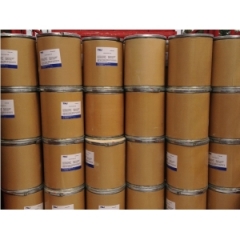1. Chemical structure and physicochemical properties
Erythritol (CAS 149-32-6), also known as protoalgae alcohol and red rabbit grass alcohol. The chemical name is 1,2,3,4-butanol, the molecular formula is c4h10o4, the molecular weight is 122.12, and the CAS number is 149-32-6.
Pure erythritol is white crystal, slightly sweet, with a relative sweetness of 0.6 ~ 0.7, cool, easily soluble in water, slightly soluble in ethanol, insoluble in ether and oil. Erythritol is very stable to heat and acid. Under general food processing conditions, there is almost no browning or decomposition. It has low hygroscopicity, good crystallinity and is easy to be crushed to produce powdered products. The melting point is 126 ℃, the boiling point is 329 ~ 331 ℃, and the heat of dissolution is - 97.4j/g. Its chemical properties are similar to those of sugar alcohols such as sorbitol, mannitol and xylitol.

Item
|
Standard
|
Reducing sugars,%
|
≤0.30
|
Ribitol and glycerol,%
|
≤0.10
|
Total arsenic /(mg/kg)
|
≤0.3
|
pH value
|
5.0~7.0
|
Conductivity,uS/cm
|
<20
|
Appearance
|
White Crystalline powder or particle
|
Mold and yeast /(CFU/g)
|
≤50
|
Melting point℃
|
119~123
|
Total plate count /(CFU/g)
|
≤100
|
Assay (dry basis),%
|
99.5~100.5
|
Ash,%
|
≤0.10
|
Drying loss,%
|
≤0.20
|
Coliform/(MPN/g)
|
≤3.0
|
Lead (mg/kg)
|
≤0.5
|
E.coli/(CFU/g)
|
<10
|
2. Main sources and production and preparation methods
The main source erythritol is widely distributed in nature. Erythritol is contained in algae, mushrooms, melons, grapes, peaches and other fruits. Because bacteria, fungi and yeast can also produce erythritol, it also exists in fermented food, fruit wine, beer and soy sauce. In addition, it also exists in human and mammalian body fluids.
Production and preparation methods erythritol production and preparation methods include chemical synthesis and microbial fermentation. Among them, microbial fermentation is the most commonly used preparation method. The method uses starch raw materials such as wheat or corn to produce glucose through enzymatic degradation, which is obtained by high permeability resistant yeast or other strains after fermentation at high concentration, concentration, crystallization, separation and drying. The industrialized production process of the fermentation method is as follows: starch → liquefaction → saccharification → glucose → fermentation of production strains → filtration → chromatography separation → purification → concentration → crystallization → separation → drying → erythritol. Compared with chemical synthesis method, the production process of this method is mild, easy to control and has more production advantages.

3. Analytical method
GB QB / T 2985-2008 high performance liquid chromatography.
No relevant literature was found in AOAC.
Other jecfas were determined by HPLC.





















 chemical.tnj
chemical.tnj